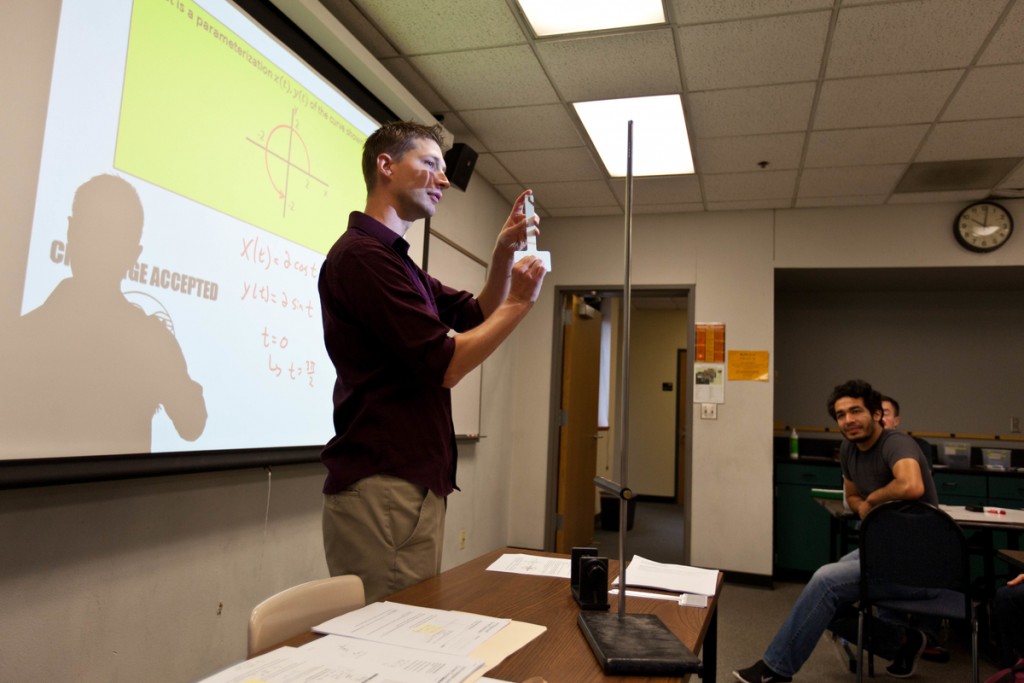
Bret Underwood, PhD
Physics Department
Flipped Learning for Student-Centered Class Time

Bret Underwood is an Assistant Professor in Physics, currently teaching a two-course Mathematical Physics sequence. The courses can be a bit technical, and he’s been spending a lot of time lately thinking about how to integrate active learning into a technical upper-level physics course. At the same time, he has become interested in the role of technology and the internet in distributing media and information to students. The fusion of these two interests has led him to completely change the structure of his Mathematical Physics courses to a more student-centered model.
What is one instructional technique or project that is particularly effective, innovative, or engaging?
“I want my students to become independent learners who are able to ‘think like a physicist’. To enable this, I try to structure my classes so that students are responsible for preparing for class and are actively involved in making sense of the material during class. I use pre-class assignments to shift the responsibility of learning the basics of the content of the course onto the students. Through readings, online videos, and pre-class questions, students prepare for class and reflect on their understanding. In-class time is spent working in groups addressing student misunderstandings, modeling physical systems, and providing opportunities for self-assessment of learning. Class time is a compelling experience that can’t be reproduced by a YouTube video, where students are actively involved in their learning and the learning of others.”
What supportive technology do you use to implement this strategy/project?
“I use Google Forms to integrate the work that students must complete before class. Every pre-class assignment contains a reading assignment, embedded YouTube videos to watch, and some reflection and self-assessment questions. What I like about Google Forms is that I can deliver the pre-class assignment directly to students’ inbox via e-mail, and the students’ responses appear directly to me in a spreadsheet. It is possible to do similar things with the Lessons tool in Sakai.
For videos, I take advantage of the resources online: for many topics in physics, I can find relevant videos on Khan Academy or YouTube videos other instructors have made. When I can’t find a video for a topic, I make my own, using a tablet PC and Camtasia Studio screen-casting software to narrate short mini-videos and post them to YouTube.”
What are the benefits, for you and your students, of utilizing this tool or strategy?
“Students really enjoy this ‘flipped’ model of learning because it makes class more meaningful for them than lectures. They can pause and rewatch the video lectures in case they missed something. The ability for students to provide feedback before every class via the pre-class assignment about what they don’t understand centers the course on their learning. In class, students get what they came to PLU for: close interaction with me and other students.
As an instructor, I enjoy this model because it forces students to take more responsibility for their learning outside of class. I find that students enter class knowing what we will be studying that day, which is refreshing. Feedback from the pre-class assignments helps me know what students are having trouble with, so I can focus my time on those areas. In class, I get to do what I came to PLU for: close interaction with my students and physics.”
What advice would you have for someone interested in trying this tool or strategy?
“Start small. Pick one class period or topic to change. You don’t have to make a new video yourself for every topic – mine the internet. I’ve found it’s important to realize that the videos are not a replacement for class. They are just the starting point, so they don’t need to be perfect. On pre-class assignments, ask students what they are confused about, and then show them the (anonymous) comments in class, briefly discussing each. This helps focus the class on student learning, rather than content. It is important to incentivize students to do the pre-class material: if class time is spent rehashing the same material from the readings/videos, then students will stop taking the pre-class work seriously.”


